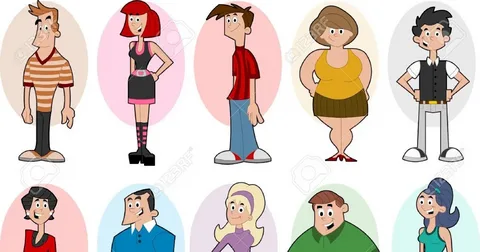An archetype in animation and illustration that has captured audiences worldwide is that of slim cartoon characters – whether classic icons like Olive Oyl and Betty Boop or contemporary favorites such as SpongeBob SquarePants or Jack Skellington – remains timeless: skinny cartoon characters. But why? And what elements make these slender figures appealing across generations?
In this comprehensive examination, we delve deep into the allure of skinny cartoon characters, uncovering psychological, sociocultural, and artistic factors which contribute to their longstanding popularity.
Understanding the Appeal of Skinny Cartoon Characters
Skinny cartoon characters captivate audiences due to their exaggerated proportions and whimsical designs, often defying reality. Their elongated limbs, slender torsos and exaggerated features give these characters an infectious energy and expressiveness that keeps viewers of all ages riveted; whether on epic adventures or everyday challenges these charming personalities leave lasting impressions that remain unforgettable.
Skinny Cartoon Characters in Popular Culture
Since their introduction, skinny cartoon characters have undergone an astounding journey that mirrors changing tastes, trends, and technologies of animation industry. Ranging from rubber hose animation in early 20th century to cutting-edge CGI today – these characters have changed alongside them and left an indelible mark on animation history.
Psychological Factors Fuelling the Appeal of Skinny Cartoon Characters
The success of skinny cartoon characters can be explained by various psychological forces, including pareidolia – where human perceive faces or human-like traits in inanimate objects – as well as animators imbuing these characters with human-like qualities, creating an emotive experience that resonates with audiences on an unconscious level.
Impact on Body Image and Self-Perception
While skinny cartoon characters may inspire admiration and affection, they also present important questions regarding body image and self-perception. In an environment defined by unrealistic beauty standards, such as that found in popular media today, their presence can perpetuate harmful stereotypes and ideals – potentially having long-term negative repercussions for mental and emotional well-being of individuals.
Diversity and Representation in Skinny Cartoon Characters
Skinny cartoon characters have long been scrutinized for their lack of diversity and representation, due to historical standards for beauty and physicality that tend to conform with normative representations of beauty and the normative experience for individuals who do not fit this mold. Recent initiatives to foster inclusivity and diversity within media has resulted in more nuanced depictions of body types and identities; challenging traditional norms and stereotypes along the way.
Controversies Surrounding Skinny Cartoon Characters Cartoon depictions of skinny characters have caused much debate, with critics alleging that these depictions perpetuate unrealistic beauty standards and contribute to body dissatisfaction and eating disorders. Furthermore, some have voiced concerns over their potential influence on young viewers; emphasizing the need for increased awareness and sensitivity in media representation.
Conclusion
Skinny cartoon characters play an intricate and diverse role in popular culture, attracting audiences with their charming charm, charismatic charm, and exaggerated proportions. While serving as sources of entertainment or inspiration, these figures also raise important issues about representation, diversity, media influence, body perception and body identity issues. Through thoughtful dialogue and critical analysis, we can better comprehend this longstanding phenomenon while striving to build an inclusive media landscape that empowers all.
FAQs:
Skinny cartoon characters tend to feature exaggerated features and eye-catching designs that draw viewers’ interest, as well as expressive personalities with relatable stories that resonate across generations. This has ensured their continued popularity for generations of viewers.
While the depiction of ultra-thin characters in media may contribute to unrealistic beauty standards, diversity and representation initiatives can reduce any adverse impact these images could have on people’s self-perception and body images.
Yes, there has been an emerging movement within the animation industry to foster inclusive and diverse media representation. Many creators are working actively against traditional norms by depicting a wider variety of body types and identities within their works.
